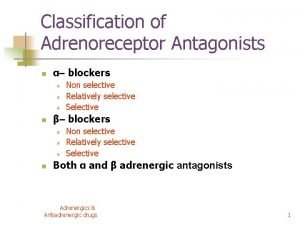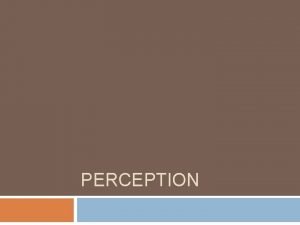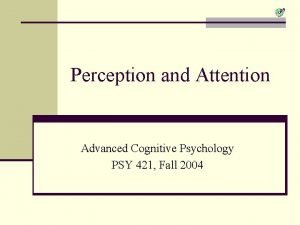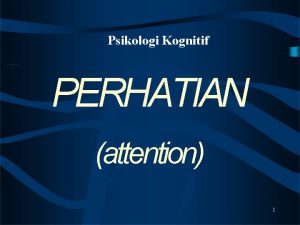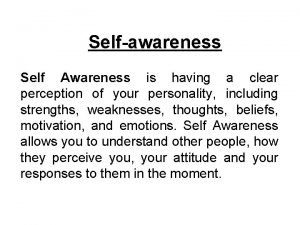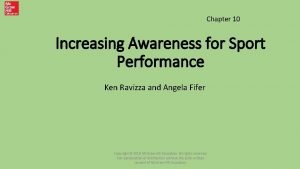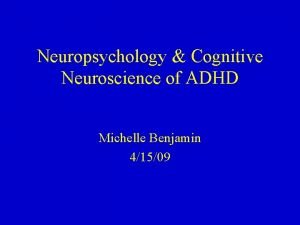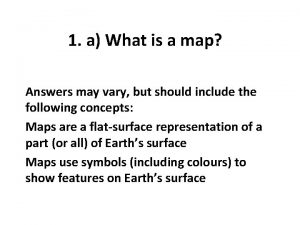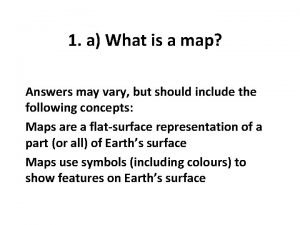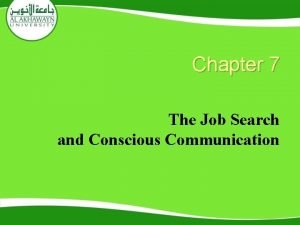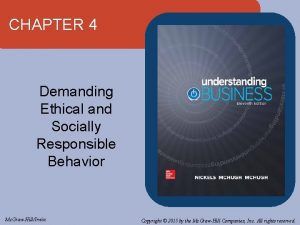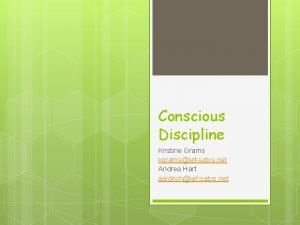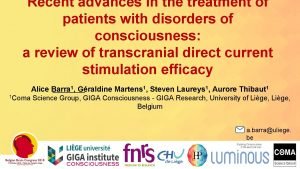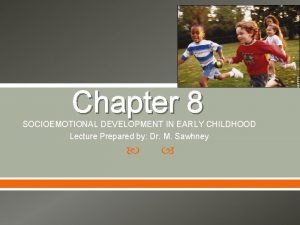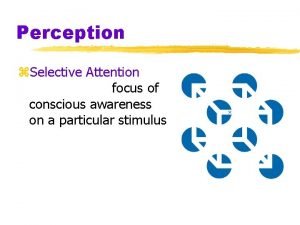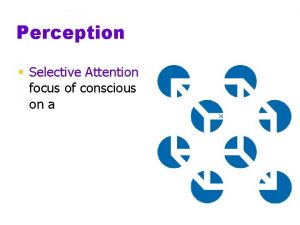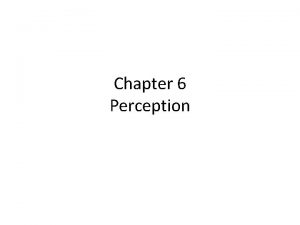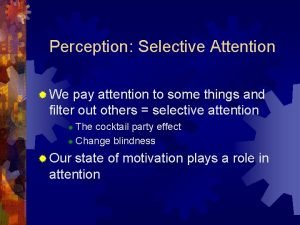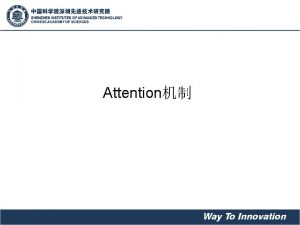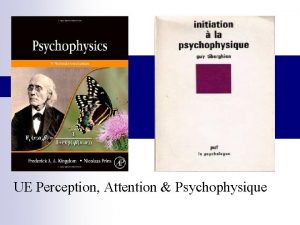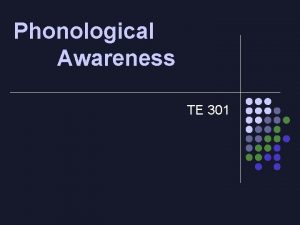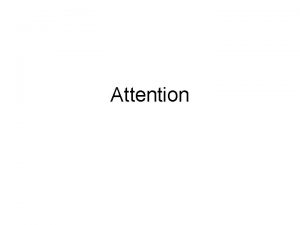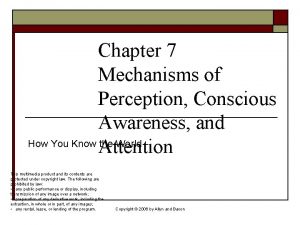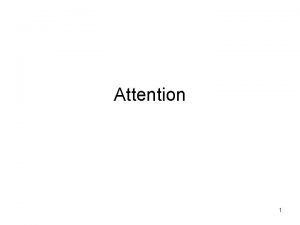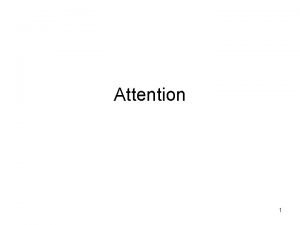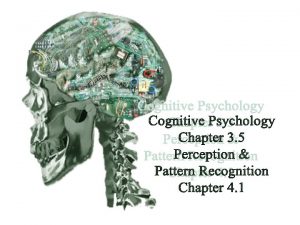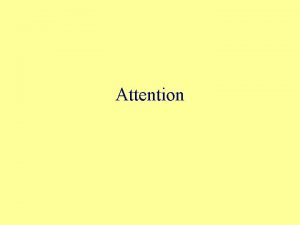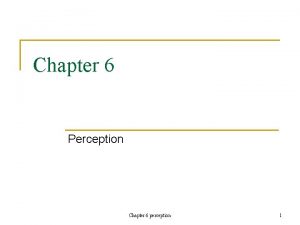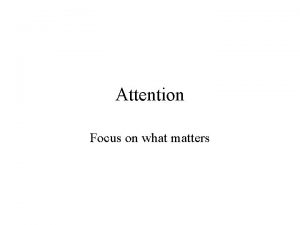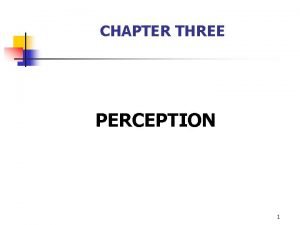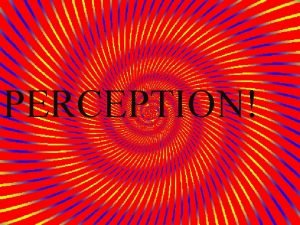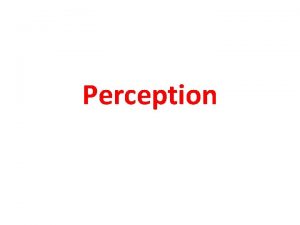Perception z Selective Attention focus of conscious awareness


























- Slides: 26

Perception z. Selective Attention focus of conscious awareness on a particular stimulus z https: //www. youtube. com/watch? v=l. Hd_L 7 dg 3 U 4 z http: //www. learner. org/series/discoveringpsychology/07/e 07 expand. html z http: //www. dailymotion. com/video/xq 1 rfl_national-geographic-test-your-brain-episode-2 perception_shortfilms

Testing Selective Attention

Selective Attention z Selective Attention means that at any moment, awareness focuses on only a limited aspect of all that we are capable of experiencing. For example, even if a stimulus figure can evoke more than one perception, we consciously experience only one at a time. z Another example of selective attention: the cocktail party effect z also limits our perception, as many stimuli will pass by unnoticed.

Inattentional Blindness What is Inattentional Blindness? Selective attention also limits our perception, as many stimuli will pass by unnoticed. This lack of awareness is evident in studies of inattentional blindness. Forms of this include: ychange blindness ychange deafness ychoice blindness http: //www. gocognitive. net/sites/default/files/change_blindness. v. 0. 93_0. swf

What is Choice Blindness z. Petter Johansson and Lars Hall, the researchers who originally coined the term, people ". . . often fail to notice glaring mismatches between their intentions and outcomes, while nevertheless being prepared to offer introspectively derived reasons for why they chose the way they did. " http: //channel. nationalgeographic. com/channel/braingames/videos/choice-blindness/

Obj. Describe the interplay between attention and perception. Answer the following question (in your own words) on the back of the paper that was placed on your desk: How does attention impact our perception? Use the following terms in your answer: z. Choice-blindness z. Inattentional blindness z. Cocktail party effect z. Selective attention z. Top-Down

Perceptual Illusions Muller-Lyer Illusion-

Perceptual Illusions

Perceptual Illusions

Perceptual Illusions

Watch This: How Brains Learn to See zhttp: //www. ted. com/talks/pawan_sinha_o n_how_brains_learn_to_see

Object Recognition z Blindness http: //www. ted. com/talks/pawan_sinha_on_how_ brains_learn_to_see z Data-Driven Processing (look at the handout 6 -4) b. Abe Lincoln (matched with objects in our long term memory and b. ) the 1 st picture on the page (a cow) data-driven and conceptually driven processing z Visual agnosia – syndrome in which all parts of the visual field are seen, but are without meaning – Read The Man Who Mistook His Wife for a Hat, by Oliver Sacks z Visual object agnosia – no damage to the eye but unable to recognize familiar objects.

4. Simultagnosia – cannot pay attention to more than one stimulus at a time. Not being able to see objects simultaneously. 5. Spatial agnosia – trouble negotiating their way through the world (wrong turns, lost in own home)

Perceptual Organization. Gestalt z. Visual Capture ytendency for vision to dominate the other senses z. Grouping ythe perceptual tendency to organize stimuli into coherent groups

Perceptual Organization. Gestalt z. Gestalt- an organized whole ytendency to integrate pieces of information into meaningful wholes z. Grouping Principles yproximity- group nearby figures together ysimilarity- group figures that are similar ycontinuity- perceive continuous patterns yclosure- fill in gaps yconnectedness- spots, lines and areas are seen as unit when connected

Perceptual Organization. Illusory Contours

Perceptual Organization z. Figure and Ground organization of the visual field into objects (figures) that stand from their (ground) out surroundings

Perceptual. Organization. Grouping Principles

Perceptual. Organization. Grouping Principles z. Gestalt grouping principles are at work here.

Perceptual Organization. Depth Perception z. Depth Perception yability to see objects in three dimensions yallows us to judge distance z. Binocular cues yretinal disparity ximages from the two eyes differ xcloser the object, the larger the disparity yconvergence xneuromuscular cue xtwo eyes move inward for near objects

Perceptual Organization. Depth Perception Visual Cliff

Perceptual Organization. Depth Perception z. Monocular Cues yrelative size xsmaller image is more distant yinterposition xcloser object blocks distant object yrelative clarity xhazy object seen as more distant ytexture coarse --> close fine --> distant

Perceptual Organization. Depth Perception Relative Size

Perceptual Organization. Depth Perception

Perceptual Organization. Depth Perception z. Monocular Cues (cont. ) yrelative height xhigher objects seen as more distant yrelative motion xcloser objects seem to move faster ylinear perspective xparallel lines converge with distance yrelative brightness xcloser objects appear brighter

Perceptual Organization. Depth Perception Perspective Techniques
 Adrenoreceptor
Adrenoreceptor Your conscious awareness of your own name and self identity
Your conscious awareness of your own name and self identity Selective perception
Selective perception Selective attention definition psychology
Selective attention definition psychology Broadbent's filter model of attention
Broadbent's filter model of attention Cognitive filter
Cognitive filter Self awareness is having a clear perception of
Self awareness is having a clear perception of Cvs privacy awareness and hipaa privacy training
Cvs privacy awareness and hipaa privacy training Awareness requires totally focusing attention on the task.
Awareness requires totally focusing attention on the task. Alternating attention vs divided attention
Alternating attention vs divided attention Maryam merrikhpour
Maryam merrikhpour How do maps help focus the reader's attention
How do maps help focus the reader's attention How do maps help focus the reader's attention
How do maps help focus the reader's attention Differentiation business level strategy
Differentiation business level strategy Porter's generic strategies
Porter's generic strategies Actor focus vs object focus
Actor focus vs object focus Prolepsis
Prolepsis The good job search and conscious communication
The good job search and conscious communication Conscious bias
Conscious bias Socially conscious research organizations
Socially conscious research organizations Conscious discipline composure
Conscious discipline composure What is the conscious discipline approach?
What is the conscious discipline approach? Minimally conscious state
Minimally conscious state Conscious proprioception
Conscious proprioception Conscious vs unconscious proprioception
Conscious vs unconscious proprioception Conscious emotions
Conscious emotions Conscious discipline brain model
Conscious discipline brain model
